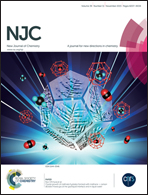Supramolecular frameworks of binuclear dioxomolybdenum(vi) complexes with ONS donor ligands using 4,4′-azopyridine as a pillar: crystal structure, DFT calculations and biological study†
Abstract
Three new isostructural pillared binuclear dioxomolybdenum(VI) complexes [(MoO2L1)2(4,4′-azpy)] (1), [(MoO2L2)2(4,4′-azpy)] (2) and [(MoO2L3)2(4,4′-azpy)] (3) [where, 4,4′-azpy = 4,4′-azobis-(pyridine)] containing tridentate binegative Schiff base ligands (H2L1, H2L2 and H2L3) obtained by the condensation of salicylaldehyde and substituted salicylaldehyde with S-benzyl dithiocarbazate have been reported for the first time. These complexes have been characterized by spectroscopic and electrochemical studies. In all the complexes (1–3), 4,4′-azpy behaves as an auxiliary spacer and bridges the Mo(VI) centers giving rise to neutral 3D supramolecular frameworks. The cavities formed by hydrogen bonding interactions are capable of hosting guest molecules. The crystal structures reveal that each molybdenum site in the binuclear complexes adopts a distorted octahedral geometry. The morphology and structures of the complexes are further examined by SEM. Thermal behavior has been investigated to study the framework stabilities of these structures. Supportive DFT calculations on the complexes have been carried out. These ligands and complexes 1–3 have significant antimicrobial and antioxidant properties.


 Please wait while we load your content...
Please wait while we load your content...